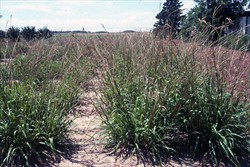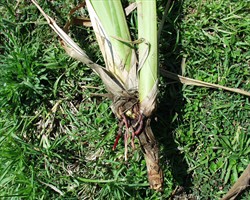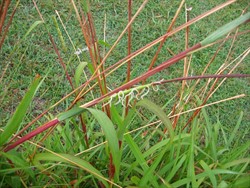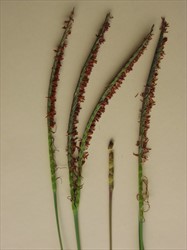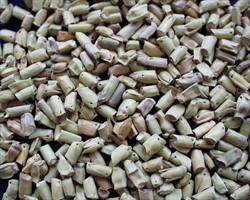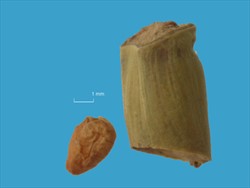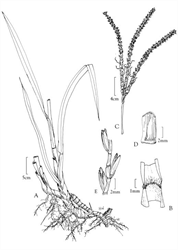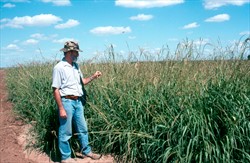Tripsacum dactyloides
Tropical Forages
Tripsacum dactyloides (L.) L.
Subordinate taxa:
Tripsacum dactyloides (L.) L. var. dactyloides
Tripsacum dactyloides (L.) L. var. hispidum (Hitchc.) de Wet & J.R. Harlan
Tripsacum dactyloides (L.) L. var. meridonale de Wet & Timothy
Tripsacum dactyloides (L.) L. var. mexicanum de Wet & J.R. Harlan
var. dactyloides: basionym Coix dactyloides L.; Tripsacum dactyloides (L.) L. var. occidentale H.C. Cutler & E.S. Anderson
var. hispidum (Hitchc.) de Wet & J.R. Harlan: Basionym: Tripsacum dactyloides subsp. hispidum Hitchc.
Family: Poaceae (alt. Gramineae) subfamily: Panicoideae tribe: Andropogoneae subtribe: Tripsacinae.
An extremely variable perennial clump grass, with short, fibrous, knotty rhizomes and deep hollow roots. Culms 1‒2.5 (‒4 m) tall, and 3‒5 cm thick at base, branching, prop-rooting from lower nodes; stems purplish, glabrous. Leaf sheath glabrous, often purplish; leaf-blade lanceolate-acuminate, to 30‒75 (‒1.5) cm long and 9‒35 (‒45) mm wide, mostly glabrous, sometimes hairy at the base of the upper blade surface; prominent midrib; margin scabrous; ligule a fringed membrane, 1‒1.5 mm long. Inflorescence 10‒20 (‒30) cm long, terminal and axillary, commonly a single raceme, or subdigitate panicle comprising 2‒3 (‒6) racemes of usually unisexual awnless spikelets (gynomonoecious types have been found); the female (pistillate) spikelets (green when immature), occupying the basal one-eighth to one-third of the raceme, inserted singly and alternately on opposite sides of the thick, hard articulate lower part of the rachis, sunken in hollows in the joints; oval in section, hard, separating into bead-like segments 7‒10 mm long at maturity: the male (staminate) spikelets 7‒11 mm long (purplish when immature) inserted in pairs either side of oblique nodes, and on one side of the flattened rachis at the terminal end of the raceme; anthers cream to orange, stigmas white to purple, to 2.5 cm long. 12,000‒15,000 seeds per kg.
Asia: 指狀加拿草 (Chinese)
English: eastern gamagrass, bullgrass, eastern mock grama, fakahatchee grass, northern gamagrass, gamagrass, sesame grass (USA)
Europe: herbe grama, herbe de gama (French); Gamagras (German); gamagräs (Swedish)
Latin America: capim-gigante (Brazil); lagón, triguillo, maicillo, maicillo oriental, maizillo, pasto Guatemala (usually reserved for T. laxum), teocintle (usually reserved for Zea), zacate maicero, zacate maiz (Spanish, Mexico)
Native
Northern America: USA (Alabama, Arkansas, Connecticut, Delaware,Florida, Georgia, Illinois, Indiana (s.), Iowa, Kansas, Kentucky, Louisiana, Maryland, Massachusetts, Mississippi, Missouri, Nebraska (s.e.), New Jersey, New York, North Carolina, Ohio, Oklahoma, Pennsylvania, Rhode Island, South Carolina, Tennessee, Texas, Virginia, West Virginia, Wisconsin); Mexico (Aguascalientes, Chiapas, Coahuila, Durango, Federal District, Guerrero, Jalisco, Mexico, Michoacán, Morelos, Nayarit, Oaxaca, Puebla, San Luis Potosí, Tamaulipas)
Caribbean: Bahamas; Cuba; Hispaniola (possibly)
Central America: Belize; Costa Rica; Guatemala; Honduras; Panama
South America: Colombia; French Guiana; Guyana; Suriname; Venezuela
Cultivated:
Also cultivated.
Forage
Primarily used as livestock forage, but may also be conserved as hay or silage.
Environment
It is also important in conservation plantings and can be used to improve wildlife habitat, as filter strips to remove excess nutrients from agricultural areas, and in prairie restoration plantings.
Other
It can be used as an ornamental, and seed can be cooked or ground into a flour.
Soil requirements
T. dactyloides is normally found on moderately well drained, fertile soils, with textures ranging from sand to clay and pH from 5.5 to 7.5. While it is also adapted to poorly drained soils, it has low salt tolerance, unlike many species from such situations. Various types of this variable species are adapted to the prairies, coastal plains, semi-arid regions, deep sandy soils, rocky outcrops, riverbanks, and openings in forested areas.
Moisture
T. dactyloides grows best in areas with annual rainfall from 900 to 1,500 mm, but can persist and remain relatively productive on better soils with rainfall as low as 600 mm. Although preferring moist, occasionally waterlogged soils as found on stream banks and around the edges of marshes, it is intolerant of permanent or near-permanent waterlogging. Stands are reduced but not killed out by 3 weeks' flooding. By virtue of a dense root system extending to 4.5 m deep, it has at least moderate drought tolerance, but produces little growth in dry weather.
Temperature
The great diversity within this species is distributed from about 42° N to 24° S, and from near sea level to 2,100 m asl, representing an unusually wide range in average annual temperatures for a single species, from below 12 to about 24 °C. Tops are burnt by heavy frost, recommencing growth in early spring. Plants survive temperatures as low as -30 °C, but require at least 140 frost free days/year for longer-term persistence.
Light
Best in full sun, but tolerates light shade.
Reproductive development
T. dactyloides is monoecious (i.e. male and female flowers rather than perfect flowers). Flowering commences early in the growing season, and is accelerated by the onset of short days; extends from April/May/June to September/October/November in the northern hemisphere, depending on provenance.
Defoliation
It is suited to managed grazing and cutting for green-chop, hay and silage. It is intolerant of continuous grazing, and is best rotationally grazed with a stubble height of 15‒20 cm (achievable with 4‒6 days' grazing and 4‒6 weeks' rest). More regular or closer grazing leads to reduction of stand. Grazing can commence when the grass reaches 45‒60 cm tall. A longer rest of about 3 months every 2‒3 years facilitates seed set and reinvigorates the stand. To obtain the best compromise between quality and quantity, hay should be cut at 15‒20 cm at early booting, roughly on a 45-day cycle (e.g. early June, mid-July, and early September in the northern hemisphere).
Fire
Stands can be burnt annually to remove low quality frosted leaf and stem, to control woody weeds, and to reduce foliar diseases, and is best done in early spring when new growth is 2‒3 cm long.
Guidelines for establishment and management of sown forages.
Establishment
Fresh seed has a high level of dormancy that can be broken by pre-chilling the seed at 5‒10 ºC for 8‒10 weeks, a process that happens naturally in colder areas with freezing and thawing. Untreated seed can be sown mid- to late winter once soil temperature falls below 10 ºC, germinating after winter when soil temperatures reach 16‒18 ºC. Pre-chilled seed is used for irrigated sowings in mid- to late spring. Seed should be placed 2‒3 cm deep into a prepared seedbed, either broadcast, covered and rolled, or planted in 50‒120 cm rows, using a sowing rate of 5‒10 kg/ha pure live seed. Since plant crowns can ultimately exceed 1 m in diameter, a final population of about 1 plant/m² is considered adequate. Closer row spacing helps suppress weeds, and the wider row spacing is best for seed production. T. dactyloides establishes slowly and competes poorly with annual grasses and broadleaf weeds in the first year. Inter-row shallow cultivation helps with weed control, and various herbicides can be used selectively.
Fertilizer
Basal and maintenance P and K should be applied in accordance with soil analysis or local practice, sufficient to support a moderate to high fertility species. In the absence of an adequate supply of N released during land preparation, apply about 50 kg/ha N when plants are ±10 cm high. For annual maintenance N, with good moisture conditions, apply 250 kg/ha, or 75‒150 kg/ha under less favourable conditions, applying 1/2 the annual total at spring green-up, and 1/4 each after the first and second harvests.
Compatibility (with other species)
No information available.
Companion species
T. dactyloides is usually grown as a pure stand, and inclusion of other species is difficult. However, in view of its soil and drainage preferences, it may grow with Panicum coloratum.
Pests and diseases
Little affected by pests and diseases, although a host plant for bunchgrass (Problema byssus), clouded (Lerema accius) and three-spotted (Cymaenes tripunctatus) skippers (Lepidoptera: Hesperiinae); the seeds are eaten by birds. Seed and forage yields are also reduced by the maize billbug (Sphenophorus maidis), the southern cornstalk borer (Diatraea crambidoides), and the southwestern corn borer (Diatraea grandiosella). Resistant to the African parasitic weed, Striga hermonthica.
Ability to spread
Can be invasive.
Weed potential
Although a good forage, it is considered by some to be a weed of pastures, hay fields, abandoned fields, roadsides, and along the edges of woods.
Nutritive value
Like maize, T. dactyloides is a C4 grass, and exhibits the same rapid decline in feeding value found in other C4 species. CP levels of young growth are commonly >15%, and IVDMD >65%, declining to 10‒14% and 56‒66% at 6 weeks, and <8% and <47% by the end of the season. Cutting for hay at ±45 days appears to produce the highest yield of total digestible nutrients/ha. Seeds contain about 27% protein, which is about 3 times the protein found in corn and twice that of wheat. Levels of the amino acid, methionine, are about twice as high as in Zea mays.
Palatability/acceptability
It is extremely palatable when young to all classes of livestock.
Toxicity
No suspicion of toxicity.
Dry matter
Well-fertilized stands under good growing conditions can produce 20‒30 t/ha/yr DM, or >10 t/ha under less ideal conditions. There are differences between provenances with regard to yield potential; e.g. in one study in Texas, accessions from Texas produced up to 3 times more forage than 'Pete', a composite of Oklahoma and Kansas accessions.
Animal production
Cattle grazing well-fertilized eastern gamagrass at 5 beasts/ha gain over 1 kg/head/day early in the growing season declining to 0.5‒0.7 kg/head/day later in the season, and averaging 0.7‒0.9 kg/head/day for the period.
Chromosome numbers vary greatly from diploid (2n = 2x = 36), to triploid (2n = 3x = 54), tetraploid (2n = 4x = 72), pentaploid (2n = 5x = 90), and hexaploid (2n = 6x = 108). Diploids reproduce sexually, whereas the polyploids are facultative apomicts. Crossing between the sexual diploids and the polyploids can occur. Gynomonoecious types may help in breeding programs to increase seed yield. Tripsacum is closely related to Zea, and it is postulated that maize (Zea mays) may be the result of a cross between T. dactyloides and a perennial variety of teosinte (Zea diploperennis). Like other Tripsacum species, T. dactyloides can hybridize with domesticated corn, although offspring of direct crosses are generally sterile. May have a role in maize improvement programs. While T. dactyloides can hybridize with T. floridanum, the hybrids are partially sterile.
T. dactyloides is very prone to seed shatter. The pistillate spikelets are embedded in the main rachis and one spikelet and an adjacent rachis internode harden and disarticulate as a dispersal unit. Seed crops are normally sown in rows 90‒120 cm apart. Tillers remain vegetative in the first season and become reproductive in the second or third season of growth. The terminal inflorescence emerges as the stalk elongates, followed 10‒14 days later by one or more lateral inflorescences from axillary nodes. This results in an asynchronous seed crop. The grass is typically cut back to a stubble the previous autumn, and fertilized with 50‒100 kg/ha N in spring when regrowth reaches 5 cm. Seed is harvested about 2 weeks after terminal seed spikes begin to shatter. Earlier harvesting results in higher levels of immature seed; later harvest results in high seed losses from shattering. Seed production potential varies among cultivars.
Tolerant of many herbicides used in corn production. Tolerant of atrazine, metolachlor, alachlor, cyanazine, nicosulfuron, rimsulfuron, 2,4-D, and dicamba, but susceptible to imazapic.
- Very palatable when young.
- High forage quality.
- High yield potential.
- Tolerant of poor drainage.
- Drought tolerant.
- Difficult to establish.
- Susceptible to continuous grazing.
- Low seed production.
Ahring, R.M. and Frank, H. (1968) Establishment of eastern gamagrass from seed and vegetative propagation. Journal of Range Management 21:27–30. journals.uair.arizona.edu/index.php/jrm/article/view/5566
Aiken, G.E. (1997) Temporal effects on steer performance and nutritive values for eastern gamagrass grazed continuously for different durations. Journal of Animal Science 75:803–808. doi.org/10.2527/1997.753803x
Aiken, G.E. and Springer, T.L. (1998) Stand persistence and seedling recruitment for eastern gamagrass grazed continuously for different durations. Crop Science 38:1592–1596. doi.org/10.2135/cropsci1998.0011183X003800060030x
Anderson, R.C. (1985) Aspects of the germination ecology and biomass production of eastern gamagrass (Tripsacum dactyloides L.). Botanical Gazette 146:353–364. jstor.org/stable/2474541
Bidlack, J.E., Vaughan, J.E. and Dewald, C.L. (1999) Forage quality of 10 Eastern gamagrass [Tripsacum dactyloides (L.) L.] genotypes. Journal of Range Management 52:661–665. journals.uair.arizona.edu/index.php/jrm/article/view/9471
Brejda, J.J., Brown, J.R., Lorenz, T.E., Henry, J. and Lowery, S.R. (1997) Variation in eastern gamagrass forage yield with environments, harvests, and nitrogen rates. Agronomy Journal 89:702–706. doi.org/10.2134/agronj1997.00021962008900040026x
Brejda, J.J., Kremer, R.J. and Brown, J.R. (1994) Indications of associative nitrogen fixation in eastern gamagrass. Journal of Range Management 47:192–196. journals.uair.arizona.edu/index.php/jrm/article/view/8927
Burns, J.C., Fisher, D.S., Pond, K.R. and Timothy, D.H. (1992) Diet characteristics, digesta kinetics, and dry matter intake of steers grazing eastern gamagrass. Journal of Animal Science 70:1251–1261. doi.org/10.2527/1992.7041251x
Burson, B.L., Voigt, P.W., Sherman, R.A. and Dewald, C.L. (1990) Apomixis and sexuality in eastern gamagrass. Crop Science 30:86–89. doi.org/10.2135/cropsci1990.0011183X003000010020x
Dewald, C.L. (2001) Eastern Gamagrass - past, present and future prospectus. Proceedings of the 56th southern pasture and forage crop improvement conference, Springdale, AR, USA, 21–22 April 2001.
Dewald, C.L. and Kindiger, B. (2000) Genetic advances in eastern gamagrass seed production. In: Moore, K.J. and Anderson, B.E. (eds) Native warm season grasses: Research trends and issues. CSSA Special Publication Vol. 30. CSSA, Madison, WI, USA. p. 123–132. doi.org/10.2135/cssaspecpub30.c8
deWet, J.M.J., Harlan, J.R. and Brink, D.E. (1982) Systematics of Tripsacum dactyloides (Gramineae). American Journal of Botany 69:1251–1257. doi.org/10.2307/2442749
Fine, G.L., Barnett, F.L., Anderson, K.L., Lippert, R.D. and Jacobson, E.T. (1990) Registration of ‘Pete’ eastern gamagrass. Crop Science 30:741–742. doi.org/10.2135/cropsci1990.0011183X003000030057x
Gillen, R.L. (2001) Production and Grazing Management for Eastern Gamagrass. Proceedings of the 56th southern pasture and forage crop improvement conference, Springdale, AR, USA, 21–22 April 2001.
Gillen, R.L., Berg, W.A., Dewald, C.L. and Sims, P.L. (1999) Sequence grazing systems on the Southern Plains. Journal of Range Management 52:583–589. journals.uair.arizona.edu/index.php/jrm/article/view/9460
Horner, J.L., Bush, L.J., Adams, G.D. and Taliaferro, C.M. (1985) Comparative nutritional value of eastern gamagrass and alfalfa hay for dairy cows. Journal of Dairy Science 68:2615–2620. doi.org/10.3168/jds.S0022-0302(85)81145-0
Lemke, B.M., Gibson, L.R., Knapp, A.D., Dixon, P.M., Moore, K.J. and Hintz R. (2003) Maximizing seed production in eastern gamagrass. Agronomy Journal 95:863–869. doi.org/10.2134/agronj2003.8630
Polk, D.B. and Adcock, W.L. (1964) Eastern gamagrass. The Cattleman 50:82–83.
Springer, T.L. and Dewald, C.L. (2004) Eastern gamagrass and other Tripsacum species. In: Moser, L.E., Burson, B.L. and Sollenberger, L.E. (eds) Warm-Season (C4) Grasses. Agronomy Monograph No. 45. ASA, CSSA, SSSA, Madison, WI, USA. p. 955–973. doi.org/10.2134/agronmonogr45.c29
Springer, T.L., Sims, P.L. and Gillen, R.L. (2004) Estimate of forage yield loss in eastern gamagrass due to shoot boring insects. Proceedings of the American Forage Grassland Council 13:333–336. ars.usda.gov/research/publications/publication/?seqNo115=164141
'Bumpers' Released in Arkansas (2005). Initially, NRCS 9058495 was one of a total of 252 accessions collected from eastern Oklahoma, southern Missouri, and western Arkansas evaluated. From these initial evaluations, 'Bumpers' was determined to have superior vigour, growth form and development, and disease resistance.
'Highlander' (PI 634941, NRCS 9062680) Released in Mississippi, USA (2003). Tetraploid from Montgomery County, Tennessee (36.5º N, 115 m asl, rainfall 1,240 mm). Selected from 72 initial collections and 12 superior forage selections for superior vigour, growth form, disease resistance and forage attributes. Appears resistant to Rhizoctonia sp. and Pythium sp. and reproduces by facultative apomixes. 'Highlander' is intermediate in height between 'Jackson' and 'Pete'.
'Iuka' Released in USA (1995). Diploid composite developed from 500+ plant collection from Oklahoma, Texas, Kansas, and Arkansas assembled by the SPRRS, Woodward, Oklahoma. 21 plants were selected on apparent forage value. This broad genetic base comprising original selections and their hybrids is widely adapted.
'Jackson' (PI 595896, NRCS 9043740) Released in Texas, USA (1998). Tetraploid from Jackson County, Texas (29º N, 20 m asl, rainfall 1,020 mm). Selected from 86 collections from approximately 60 Texas counties. Evaluated for forage abundance, seed production, plant vigour, and stand persistence. 'Jackson' was one of three collections chosen for their superior performance, which were then evaluated for dry matter yield and digestibility. 'Jackson' produced higher DM yield/ha than 'Pete' and displayed good regrowth after clipping as well as good resistance to insects and diseases. With a foliage height of 1.5 m and plant height of 2.5 m, 'Jackson' is taller than 'Highlander' and 'Pete'.
'Martin' (NRCS 9056069) Released in Florida, USA (2000). Diploid germplasm from Martin County, Florida (27º N, 9 m asl, rainfall, 1,400 mm). Selected from 114 Florida and 36 Kansas accessions for its blue-green colour, wider leaves, growth habit and ability of the foliage to maintain its colour despite light frosting. Because it is outcrossing, it must be propagated vegetatively to maintain the blue-green leaf colour. Early flowering; leaves often arch when they are mature; stems dark purple. Foliage height is about 70 cm and plant height about 120 cm.
'Medina' (PI 595897, 9043762) Released in Texas, USA (2000). Tetraploid from Medina County, Texas (29º N, 250 m asl, rainfall 750 mm). One of three elite accessions selected from 86 collections from throughout Texas for leafiness, seed production, plant vigour, and stand persistence. Produces c. 50% higher DM yield than 'Pete'. Foliage height 140 cm, plant height 2 m,. good regrowth after clipping, and good seed production.
'Pete' (PI 421612, PMK-24) Released in Kansas and Oklahoma, USA (1988). Diploid composite of 70 accessions originating as seed from native populations in Kansas and Oklahoma. Considered to have application between 34 and 43º latitude. Although lower growing than 'Jackson' and 'Highlander', 'Pete' is still capable of producing >20 t/ha/yr DM.
'San Marcos' (PI 434493, PMT-832) Released in USA (2000). Tetraploid germplasm from Hays County, Texas (30º N, 240 m asl, rainfall 825 mm). Adapted to a wide range of soil types but best on sandy loams, clay loams, and clay soils. Useful from about 29 to 35º latitude where 'Pete' and 'Iuka' are less vigorous than many southern tetraploids.
'St Lucie' (NRCS 9059278) Released in Florida, USA (2000). Diploid germplasm from St Lucie County, Florida (27º25' N, 5 m asl, rainfall 1,370 mm). Selected from 114 Florida accessions and 36 Kansas accessions for distinctive blue leaf colour, growth habit and ability of the foliage to maintain its blue colour even when lightly frosted. Plant height about 1.5 m, with culms to 2.1 m; stems dark red. Since it is outcrossing, vegetative propagation is necessary to insure the blue colour is maintained.
'Texas Sue' Released in Florida, USA (2004). From a native stand in central Texas. Average plant height 1.2 m, with culms to >2 m.
GSF I (PI 483447) Manhattan, Kansas, Plant Materials Center, and the Southern Plains Range Research Station, Woodward, Oklahoma. S ingle plant from Ottawa County, Kansas (39º N, 400 m asl, rainfall 700 mm). Semi-prostrate in growth habitat, with relatively narrow leaves. Susceptible to leaf rust and anthracnose. Differs from other germplasm in having gynomonoecious inflorescences (female flowers below and hermaphroditic flowers above on the same structure) and smaller seeds. Potential to produce higher seed numbers and yield than the normal form. GSF I has slightly fewer spikelets with functional anthers, slightly narrower leaves, and darker purple stigmas than GSF II. Source of genetic material to increase seed production in monoecious varieties.
GSF II (PI 483448) Manhattan, Kansas, Plant Materials Center, and the Southern Plains Range Research Station, Woodward, Oklahoma. Single plant from Ottawa County, Kansas (39º N, 400 m asl, rainfall 700 mm). Semi-prostrate in growth habitat, with relatively narrow leaves. Susceptible to leaf rust and anthracnose. Differs from other germplasm in having gynomonoecious inflorescences (female flowers below and hermaphroditic flowers above on the same structure) and smaller seeds. Potential to produce higher seed numbers and yield than the normal form. GSF II has slightly more spikelets with functional anthers, slightly broader leaves, and paler purple stigmas than GSF I. Source of genetic material to increase seed production in monoecious varieties.
